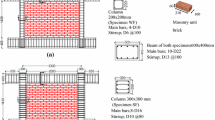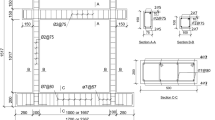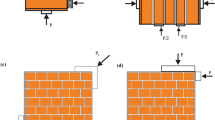Abstract
This study focuses on the in-plane behaviour of unreinforced masonry (URM) infill walls installed in reinforced concrete (RC) frames. Five 1/4-scale model frames were designed based on a prototype RC building with URM infill walls in Turkey. The experimental parameters were the layout of the URM infill (its presence or absence), number of spans (single or double), number of stories (single or double), and stacking pattern of the URM infill (horizontal or vertical). Static cyclic loading tests were conducted to investigate the lateral force resisting mechanisms in the in-plane direction, which were evaluated based on the strain data measured on blocks forming the infill walls. The results indicated the following: (1) The vertically stacked infill did not form a typical diagonal compressive strut and showed lower seismic performance than the horizontally stacked infill. (2) For the specimens with horizontally stacked infill, the one-story, two-bay specimen formed a diagonal compressive strut in each infill wall similar to that formed in the one-story, one-bay specimen, whereas a steeper compressive strut through both stories appeared in the two-story, one-bay specimen. To verify the above strut mechanisms in the horizontally stacked infill, the compressive struts in the specimens were quantitatively identified based on strain data recorded on the infill. The identified compressive struts indicated that single strut models were applicable to multi-bay infilled frames; however, the stress transfer across floors should be considered in multi-story frames.

















Similar content being viewed by others
Abbreviations
- Δ, R :
-
Lateral drift and drift angle at the uppermost beam in a specimen
- H :
-
Internal height of the wall
- Q My , Q Sy :
-
Shear force at flexural yielding and shear strength
- c M c , b M c :
-
Cracking moment of the column and beam
- c θ c , b θ c :
-
Rotation angle of the column and beam at the cracking moment
- f ′ c :
-
Compressive strength of concrete
- Z :
-
Section modulus
- N, σ 0 :
-
Axial force and axial stress
- b, D, d, h 0, l 0 :
-
Width, depth, effective depth, clear height of the column, and clear length of the beam
- E, I :
-
Young’s modulus and cross-sectional moment of inertia
- c M y , b M y :
-
Flexural yield moment of the column and beam
- c θ y , b θ y :
-
Rotation angle of the column and beam at the flexural yield moment
- g 1 :
-
Ratio of the spacing between the centroids of the compressive and tensile longitudinal bars to the member depth
- a t , p t, p w :
-
Gross area of tensile reinforcement and tensile and shear reinforcement ratios
- f y , f wy :
-
Yield stress of the longitudinal and shear reinforcements
- a :
-
Depth of the equivalent rectangular stress block
- j :
-
Distance between the centroids of the tensile and compressive stresses
- c α y , b α y :
-
Reduction factor of the secant stiffness at yielding to the elastic stiffness of the column and beam
- n :
-
Ratio of the Young’s modulus of the reinforcement to that of the concrete
- a′, η 0 :
-
Shear span and axial force ratio (=N/bDf ′ c )
- M/(Qd):
-
Shear span-to-effective depth ratio (=h 0/(2d))
- ε j , θ j :
-
Principal compressive strain of the jth block unit
- ε cm :
-
Compressive strain at the maximum strength recorded during the prism test
- θ :
-
Main diagonal strut angle
- ε i :
-
Compressive strain of the ith section
- ε m :
-
Mean value of the compressive strain
- C y, i :
-
Central axis distance of the ith section
- C y :
-
Equivalent central axis distance of the evaluated strut
- W e, i :
-
Effective width of the ith section
- W eq :
-
Equivalent diagonal compressive strut width
- σ m :
-
Equivalent compressive stress acting within the evaluated compressive strut
- t :
-
Wall thickness
- y i :
-
Distance of each block in the ith section from the reference line
- V C :
-
Lateral shear strength of the URM infill wall
References
American Concrete Institute (ACI) (2014) Building code requirements for structural concrete (ACI 318-14)
Architectural Institute of Japan (AIJ) (2016) AIJ standard for lateral load-carrying capacity calculation of reinforced concrete structures (in Japanese)
FEMA 306 (1998) Evaluation of earthquake damaged concrete and masonry wall buildings. Applied Technology Council (ATC-43 Project)
Gere JM, Timoshenko S (1997) Mechanics of materials, 4th edn. PWS Publishing Company, Boston
Gülkan P, Binici B, Sucuoğlu H, Taghipour A, Demirel O, Tanışer S, Güneş O, Ismail M, Fehling E, Nakano Y, Sanada Y, Choi H (2015) An innovative tie system for improving the monolithic behavior of masonry in-filled reinforced concrete frames (INFILTIE). In: 3rd Turkish national conference on earthquake engineering and seismology. 14–16 October 2015, Dokuz Eylül University, İzmir
Hashemi A, Mosalam KM (2007) Seismic evaluation of reinforced concrete buildings including effects of masonry infill walls. In: PEER report 2007/100, Pacific Earthquake Engineering Research Center
Holmes M (1961) Steel frames with brickwork and concrete infilling. Proc Inst Civil Eng 19:473–478. doi:10.1680/iicep.1961.11305
Jin KW, Choi H, Nakano Y (2016) Experimental study on lateral strength evaluation of unreinforced masonry-infilled RC frame. Earthq Spectra 32:1725–1747. doi:10.1193/00714EQS152M
Maidiawati Sanada Y, Konishi D, Tanjung J (2011) Seismic performance of nonstructural brick walls used in Indonesian R/C buildings. J Asian Archit Build Eng 10:203–210. doi:10.3130/jaabe.10.203
Mainstone RJ (1971) Summary of paper 7360: on the stiffness and strength of infilled frames. Proc Inst Civil Eng 49:230. doi:10.1680/iicep.1971.6267
Stafford SB, Carter C (1969) A method of analysis for infill frames. Proc Inst Civil Eng 44:31–48. doi:10.1680/iicep.1969.7290
Turgay T, Durmus MC, Binici B, Ozcebe G (2014) Evaluation of the predictive models for stiffness, strength, and deformation capacity of RC frames with masonry infill walls. J Struct Eng 140:06014003. doi:10.1061/(ASCE)ST.1943-541X.0001069
Acknowledgements
The project was funded by the CONCERT-Japan (Connecting and Coordinating European Research and Technology Development with Japan) project (Project leader: Professor P. Gülkan, currently at Middle East Technical University, Northern Cyprus Campus, Turkey, with support provided by the Scientific and Technological Research Council of Turkey under Project 113M557, Project leader in Japan: Professor Y. Nakano) under JST (Japan Science and Technology Agency). The authors are thankful to both agencies for their financial support.
Author information
Authors and Affiliations
Corresponding author
Rights and permissions
About this article
Cite this article
Suzuki, T., Choi, H., Sanada, Y. et al. Experimental evaluation of the in-plane behaviour of masonry wall infilled RC frames. Bull Earthquake Eng 15, 4245–4267 (2017). https://doi.org/10.1007/s10518-017-0139-1
Received:
Accepted:
Published:
Issue Date:
DOI: https://doi.org/10.1007/s10518-017-0139-1




